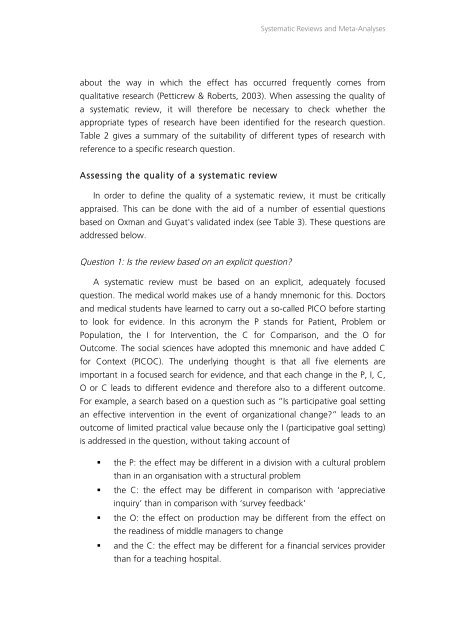In Search of Evidence
jqluvth
jqluvth
You also want an ePaper? Increase the reach of your titles
YUMPU automatically turns print PDFs into web optimized ePapers that Google loves.
Systematic Reviews and Meta-Analyses<br />
about the way in which the effect has occurred frequently comes from<br />
qualitative research (Petticrew & Roberts, 2003). When assessing the quality <strong>of</strong><br />
a systematic review, it will therefore be necessary to check whether the<br />
appropriate types <strong>of</strong> research have been identified for the research question.<br />
Table 2 gives a summary <strong>of</strong> the suitability <strong>of</strong> different types <strong>of</strong> research with<br />
reference to a specific research question.<br />
Assessing the quality <strong>of</strong> a systematic review<br />
<strong>In</strong> order to define the quality <strong>of</strong> a systematic review, it must be critically<br />
appraised. This can be done with the aid <strong>of</strong> a number <strong>of</strong> essential questions<br />
based on Oxman and Guyat's validated index (see Table 3). These questions are<br />
addressed below.<br />
Question 1: Is the review based on an explicit question?<br />
A systematic review must be based on an explicit, adequately focused<br />
question. The medical world makes use <strong>of</strong> a handy mnemonic for this. Doctors<br />
and medical students have learned to carry out a so-called PICO before starting<br />
to look for evidence. <strong>In</strong> this acronym the P stands for Patient, Problem or<br />
Population, the I for <strong>In</strong>tervention, the C for Comparison, and the O for<br />
Outcome. The social sciences have adopted this mnemonic and have added C<br />
for Context (PICOC). The underlying thought is that all five elements are<br />
important in a focused search for evidence, and that each change in the P, I, C,<br />
O or C leads to different evidence and therefore also to a different outcome.<br />
For example, a search based on a question such as “Is participative goal setting<br />
an effective intervention in the event <strong>of</strong> organizational change?” leads to an<br />
outcome <strong>of</strong> limited practical value because only the I (participative goal setting)<br />
is addressed in the question, without taking account <strong>of</strong><br />
! the P: the effect may be different in a division with a cultural problem<br />
than in an organisation with a structural problem<br />
! the C: the effect may be different in comparison with ‘appreciative<br />
inquiry’ than in comparison with ‘survey feedback’<br />
! the O: the effect on production may be different from the effect on<br />
the readiness <strong>of</strong> middle managers to change<br />
! and the C: the effect may be different for a financial services provider<br />
than for a teaching hospital.


